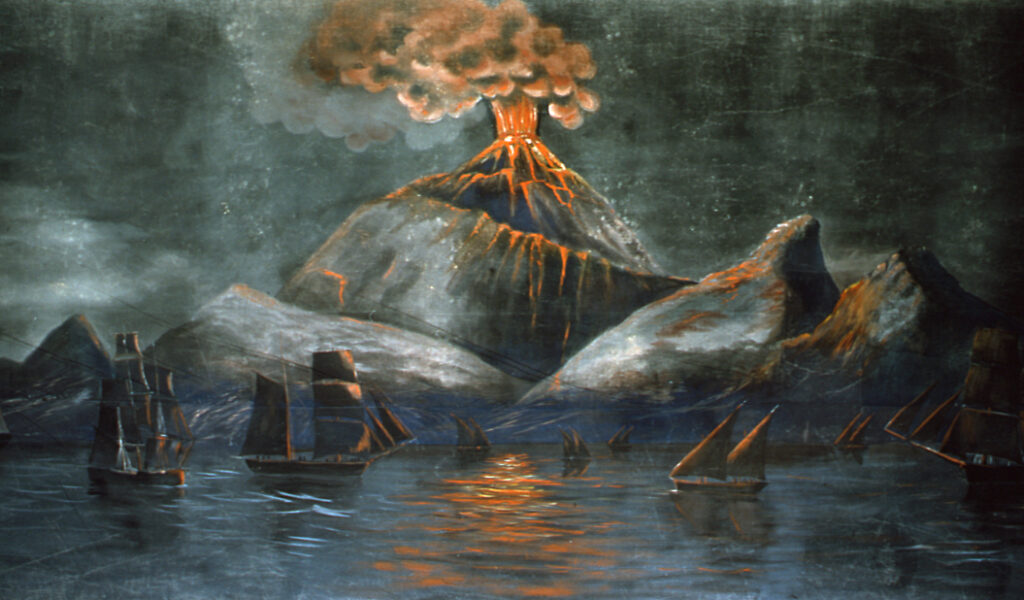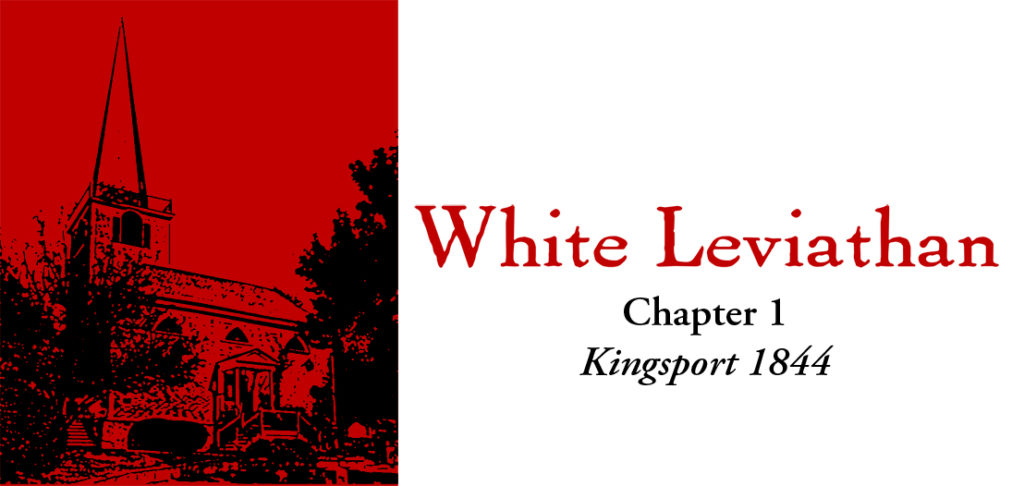Kingsport 1844: Pickering Hall
- At August 19, 2021
- By Great Quail
- In Call of Cthulhu
 0
0
25) Pickering Hall
105 Hall Street, Prospect Hill. Est. 1836
A) Pickering Hall
Dominating Hall Street between Tuttle and Caldecott, Pickering Hall is a neoclassical amphitheater built by the Pickering family as a community center for theater, concerts, and lectures. Recent popular events have included the Virginia Serenaders Minstrel Show, a surprisingly adept production of Shakespeare’s Richard III, and a speech by Frederick Douglass sponsored by the Miskatonic Valley Anti-Slavery League.
Pickering Hall is currently being rented by Jonah Folger for a fortnight-long production of his masterpiece, “Jonah’s Amazing Whaling Panorama.” In the middle of a year-long tour of the United States, Folger has booked his panorama in Kingsport from October 18 to November 2, playing every night but Sundays with a matinee each Saturday. Broadsides advertising the spectacle have been plastered all over the Miskatonic Valley the last two months. Shows start promptly at 7:00 pm, although the October 31 performance will be cancelled because of the storm.
| Panoramas A panorama is the equivalent of an early nineteenth-century motion picture. A long, continuous painting connected by two cylinders, the panorama is unrolled using a hand-crank. A narrator provides dramatic continuity, often to musical accompaniment, off-stage sound cues, and special lighting effects. There may even be pyrotechnics. Jonah’s panorama is loosely based on an actual whaling panorama famous during this period: Benjamin Russell and Caleb Purrington’s “Panorama of a Whaling Voyage Around the World,” scenes from which may be found in any book about Yankee whaling. Currently in the collection of the Whaling Museum of New Bedford, the museum produced a 47-minute long video of Russell’s panorama available on Vimeo. There’s also a narrated YouTube version; and the panorama itself is currently on display at Mystic Seaport. |
B) Jonah’s Amazing Whaling Panorama
A labor of love taking five years to research and complete, the panorama is the brainchild of New Bedford poet Jonah Folger. In 1835 Folger shipped on a two-year whaling voyage, taking copious notes and sketches along the way. Returning home, Folger partnered with Brooklyn sign painter Laurence Jackson, and over the next three years, they produced a spectacular, full-color panorama of Folger’s voyage—with dramatic embellishments, naturally. Eight feet tall and nearly a quarter-mile long, “Jonah’s Amazing Whaling Panorama” is painted on five long segments of cotton sheeting, and takes ninety minutes to narrate and unwind.
The panorama details a harrowing voyage from New Bedford onboard the fictional whaleship Jacquelyn. The Azores are visited, a volcano erupts off the coast of the Cape Verde Islands, and Cape Horn is rounded by a small fleet of whalers—with a terrible storm sinking one of them, of course. Numerous whales are pursued in the Pacific, leading to a particularly livid trying-out sequence that spares no gory details. After a stop in the Sandwich Islands—complete with scandalously semi-nude women and frolicking sailors—the whaleship Sussex sets sail for “uncharted grounds.” Needless to say, the Sussex is stove by an enraged Parmaceti and sunk! (A sequence inspired by the Essex, a true-to-life whaleship destroyed by a sperm whale in 1821.) A sub-plot develops showing castaways landing on a jungle island and fighting off cannibals, but they are rescued by the ever-trusty Jacquelyn. The panorama ends with the safe return of the Jacquelyn, her hold filled with oil. The last scene shows a housewife lighting a spermaceti candle and trimming the wick of a whale-oil lantern, an actual one which is then—ta da!—produced by the narrator.
 Excerpt from Purrington & Russell’s actual panorama; from the New Bedford Whaling Museum
Excerpt from Purrington & Russell’s actual panorama; from the New Bedford Whaling Museum
C) Personalities
The panorama is narrated by Jago Crumb, a Boston actor who worked closely with Folger and Jackson in mastering the details of the voyage. A full-bodied, jolly man with bushy sideburns, Crumb is a vivid narrator, investing each sequence with a palpable degree of wonder and terror. Although he is not a whaler himself, he’s surprisingly knowledgeable about the peculiarities of the trade, and enjoys taking “tough questions” from his audience after the performance has concluded.
Jago is assisted by his teenage nephew, Sullivan Crumb. “Sully” is stationed behind the panorama, where he triggers sound cues such as bells, thunder, and crackling fire. He also has a few practical effects to master. During the whale attack on the Sussex, Sully pulls a cord that sprinkles water over the unsuspecting crowd, while the trying-out sequence demands a burning smudge pot. The pièce de résistance is an “actual harpoon” which is flung through the panorama and caught by Jago Crumb—“Ho ho! While I enjoy my pudding, I’m not as big as the whales, my hearty boys!” (Here, the cotton panorama features a paper window which is repaired nightly.)
Isaac Townshend
Whenever the venue features a piano, a musician is hired to provide accompaniment, and Pickering Hall possesses a brand-new Erard shipped from Paris. Located behind the panorama, it provides a jaunty soundtrack to the action. Any musically-oriented Art and Craft roll immediately appreciates the talent of hidden piano player, with a Hard success recognizing avant-garde elements such as chromaticism and dissonant clusters. For the past several venues, the piano has been played by “Professor” Isaac Townshend, a young black pianist from New York City. Something of a musical genius, Townshend takes pride in the fact that he never falls into a rut. Every night, he varies his performance, his improvisations adopting a unique chromatic style that anticipates Richard Wagner’s Romanticism. Kingsport will be the last city that Townshend plays, however—his work with the panorama has so inflamed his passions that he’s decided to experience whaling for himself. Three days after entering Kingsport, Isaac Townshend quietly signed the articles of the Quiddity. He has no plans to inform Folger, and has no compunctions about leaving his employer high and dry. After all, Folger’s previous pianist, a white man, was situated in front of the panorama! (See “Quiddity Crew” for details on Townshend.)
D) Viewing the Panorama
Viewing the panorama is an excellent opportunity for the Keeper to narrate the fundamentals of whaling, foreshadow future adventures in store for the characters, and hint at Whipple’s experiences when cast adrift last voyage. (The act of whaling is described in “Hunting Whales” and “Trying-Out a Whale.”) There’s a game-related benefit to attending the show as well. Viewing “Jonah’s Amazing Whaling Panorama” automatically adds 2D4 points in Whalecraft to anyone with a score under 10%.
After the show is over, player characters may meet Jonah Folger, Jago Crumb, Sully Crumb, or Isaac Townshend. While Folger is a teetotaler who plans on retiring back to the Kingsport Hotel, Jago, Sully, and Isaac are always up for libations.
White Leviathan > Chapter 1—Kingsport 1844
[Back to “Prospect Hill” | White Leviathan TOC | Forward to “South Shore”]
Author: A. Buell Ruch
Last Modified: 16 November 2021
Email: quail (at) shipwrecklibrary (dot) com
White Leviathan PDF: [TBD]

